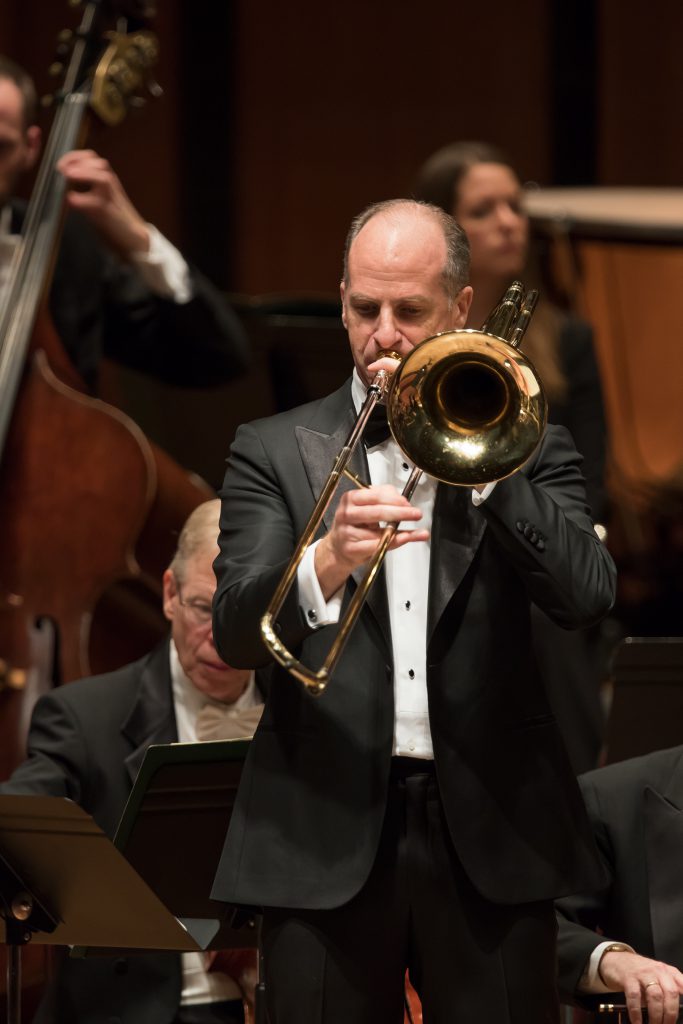Mulcahy, NSO provide inspired advocacy for Rouse’s compelling concerto

Craig Mulcahy performed Christopher Rouse’s Trombone Concerto with Christoph Eschenbach and the National Symphony Orchestra Thursday night. Photo: Scott Suchman
Christoph Eschenbach has made a point of featuring National Symphony Orchestra musicians as concerto soloists over the years. The latest such hometown nod, heard Thursday evening at the Kennedy Center Concert Hall, was principal trombonist Craig Mulcahy, who took the solo part in Christopher Rouse’s Trombone Concerto.
This was the NSO’s first performance of the piece, which won its composer the Pulitzer Prize for music in 1993. It is most successful in its outer movements, with slow burns surrounding a central fast scherzo, in an inversion of the conventional concerto tempo ordering. In the opening sequence, a fog of drum and metallic percussion strikes, harp twangs, and sustained low notes, Mulcahy rose out of the texture on long, deep notes that awakened the rest of the strings, growing in volume on clusters and diverging into clashes. Even at the height of this clamor, with all the percussion crashing away, the trombone could still make itself heard, which is its principal virtue in orchestration.
After a more melodic cadenza, in which Mulcahy’s playing was more introspective, the second movement erupted in a crazy profusion of notes. A middle jig-like section was less dissonant, ended by another outburst of percussion and cacophony across the orchestra, the trumpets chattering noisily amid the mayhem.
Rouse’s large battery included at this point some frantic strikes with a huge hammer, recalling the climaxes of Mahler’s sixth symphony, where a hero is felled by an ax. Leonard Bernstein, who had died the year before Rouse began composing the piece, is the dedicatee of this concerto and, seemingly, the fallen hero of the piece. Throughout the concerto, Mulcahy played with unflagging breath support and beauty of tone, even at the extreme ends of the instrument’s range.
In the third movement Rouse quotes musical material from Bernstein’s Third Symphony (“Kaddish”), itself a work of remembrance written in the wake of the assassination of President Kennedy. With the timpani and low strings setting the pace, the orchestra embarked on a powerful funeral march, growing gradually in volume and level of dissonance. After a solo section, featuring the lamenting solo trombone punctuated by bass drum, Eschenbach led the NSO through a gigantic crescendo. Apart from some wobbly sounds in the horns, the playing was excellent throughout. After an elegiac section for the soloist, with a melodic similarity to Bernstein’s song “Somewhere” from West Side Story, the piece seemed to descend into the tomb, as the solo trombone and contrabassoon sank lower and lower in pitch.
To counteract the somber mood, Eschenbach ended the concert with a jocular reading of Beethoven’s Eighth Symphony. He and the musicians hit an optimal tempo for the first movement, not too fast, with the brio the composer wanted rendered in clipped accents and sharp attacks. Sweet hesitations enlivened the second theme, and another powerful crescendo marked the return of the opening material. The two compact inner movements showed all the musicians and their conductor on the same page, especially the earthy, jovial slow movement marked with charming guffaw-like sounds.
The tempo of the third movement did recall a minuet, as indicated, but the evenness of attack and articulation robbed the music of some of its dance-like character. Suave and elegant horn playing made the Trio of this movement a highlight. Eschenbach avoided his tendency to push tempos too fast until the last movement, which was antic and shivering, but the tempo seemed to speed up and down slightly, creating an unsettled feeling.
Eschenbach assembled a vast string section for the opening work, Tchaikovsky’s Serenade in C Major, in accordance with the composer’s wishes. Their sound was brilliant and intense on this work not played by the NSO since 1996, but Eschenbach failed to draw out a broad range of tonal colors across the four movements. The tempos often seemed rushed, except for the pleasing third movement, kept largely free of heavy rubato. Fast groups of notes blurred together in the first and fourth movements, and some ensemble misalignment made the waltz less graceful than it could have been.
The program will be repeated 8 p.m. Saturday. kennedy-center.org; 202-467-4600.

Posted Feb 04, 2017 at 10:30 am by john pitman
In reference to the wobbly French horn notes mentioned, I think the composer was expecting just a bit much for the horn to come in on such a high note successfully after a lengthy ffff section just beforehand. I mean c`mon! It was so loud that my wife covered her ears (in Row S).
However, I loved this work so much that if I wasn`t married, I`d go again tonight to hear it! This Rouse piece is a poetic monument from beginning to end and it`s not just a bunch of notes and sounds thrown together willy nilly (apparently the Pultizer committee thought so, too.). There is, to my mind anyway, much deep thought which went into it, denoted by its arch-like structure and inventive timbres. We discovered in the 20th Century that major-minor scales and related modes are not the only avenues to musical story telling. Complex harmonic movements and textures can also be employed to impart a narrative.
My wife responds mostly to the traditional classical styles, so I suggested to her before it began to view this work as piece of music for a film with the trombonist acting as narrator. To that end Mr. Mulcahy had a far-reaching story to tell–to be sure, a real test of his musical oratorical mettle. He and his orchestra formed quite the novelist collaboration.